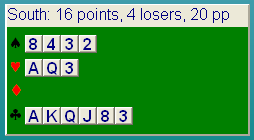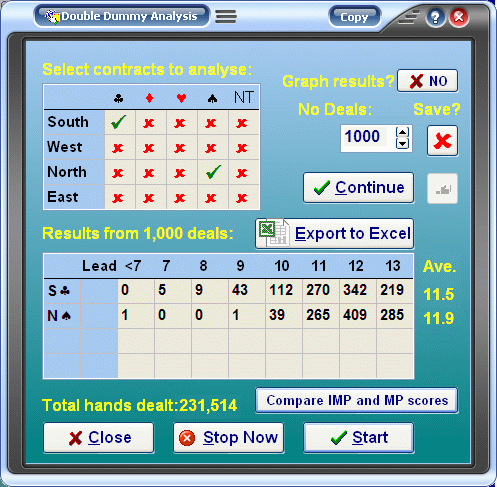
Double Dummy Analysis is one of the strongest features of Bridge Analyser. Lets see how it works with an example hand:

|
|---|
1] Your hand is:

I never get hands like that !
2] Your left hand opponent opens 1♥;
and your partner makes a weak jump overcall of 2♠
and it is passed to you. What do you do next? Several options might occur:
1] in the Analyse menu select input a single hand, input South, and save it.
2] press play, and now the South hand is fixed and the other 39 cards are being dealt to W, N & E.
3] in the Analyse menu select Bias West by bid, and select 1♥ as the opening bid.
4] from this screen select Bias North and select 2♠ as North's overcall and save.
5] open the Bid System menu, go to conventions, and check you are playing weak jump overcalls (otherwise the 2♠ overcall will be strong !) You can also select whether 1♥ is a 4 or 5 card major and what strength hands open 1N if you wish. Also check out the strength of weak 2's in the Bid System strength ranges menu as you can set it here to reflect your bidding style (weak jump overcalls use the same strength as weak 2's).
6] at this stage you can if you wish lock the dealer and/or the vulnerability or you can just leave it as random. If you lock NS as vulnerable then the 2♠ overcall will on average be a little stronger than if you lock it as not vulnerable. Also being in third seat allows weaker pre-empts so locking the dealer can also have an effect, but for my example I left both on random.
7] in the Analyse menu select Double Dummy Analysis and the screen below pops up. You now tick the two contracts to analyse - clubs by South and spades by North. (up to 4 contracts can be analysed at a time).
 |
9] select a number of deals to analyse, 100 gives you a good idea but more
will be more accurate although it takes longer. I seldom do less than
1,000 and often do more. 10] press start. Bridge Analyser deals several hundred hands a second until it finds one where there is a 1♥ opening with a 2♠ overcall. It saves this and goes off to find the next one until it has enough stored in memory to do the analysis you set up. It then feeds these hands to the double dummy solver which analyses them for tricks made by South in clubs and North in spades before going back to find another deal. You will see the results table being filled in as each new deal is analysed. If you have a multi processor machine then deals are analysed in parallel on each processor. The table left with 1,000 hands analysed will take a little over 1 minute on a quad core machine. |
The table above shows my results for 1,000 deals, so what do you conclude?
1] Bidding clubs to protect that heart holding is a waste of time (further analysis shows that you sometimes have a club loser opposite extreme shortage to go with your spade loser and anything else).
2] 7♠ is surprisingly likely to make - mainly because you often have just the king missing in spades and the finesse nearly always works because West has an opening bid.
3] Not exploring a slam is a huge mistake.
4] Further analysis of dealing the hands one at a time and looking at them yourself suggests that your best move is to make a strong bid and settle for 6♠ unless partner tries to sign off. If you play keycard blackwood then trying that and going to 7♠ over 2 key cards, 5♠ over none and 6♠ otherwise is good as two keycards is the AK of spades nearly all the time but you do risk occasionally missing the ace of trumps. The only better route I could see is bidding 5♦ as exclusion keycard balckwood (it asks for keycard blackwood responses excluding the bid suit of diamonds so the wasted diamond ace is ignored) but not many average players use those methods even though they are quite useful.
![]() See more about how results can be analysed here
This kind of analysis can be done in a variety of difficult bidding
situations and used to improve your bidding judgement, settle differences of
opinion and to assess ways of improving your bidding methods.
See more about how results can be analysed here
This kind of analysis can be done in a variety of difficult bidding
situations and used to improve your bidding judgement, settle differences of
opinion and to assess ways of improving your bidding methods.